Project on Energy Efficiency and Its Impact on Environment
VerifiedAdded on 2020/05/03
|15
|4442
|33
AI Summary
Contribute Materials
Your contribution can guide someone’s learning journey. Share your
documents today.
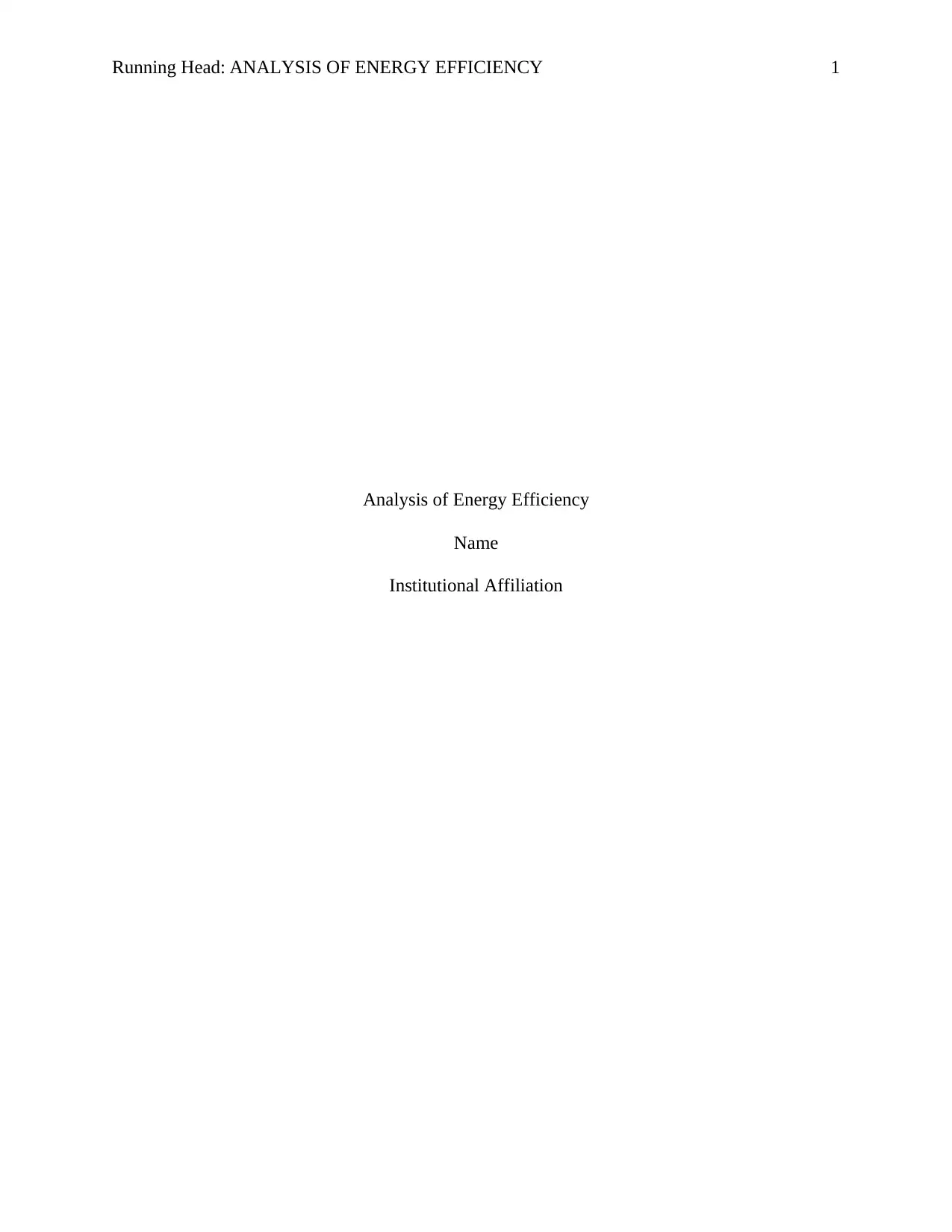
Running Head: ANALYSIS OF ENERGY EFFICIENCY 1
Analysis of Energy Efficiency
Name
Institutional Affiliation
Analysis of Energy Efficiency
Name
Institutional Affiliation
Secure Best Marks with AI Grader
Need help grading? Try our AI Grader for instant feedback on your assignments.
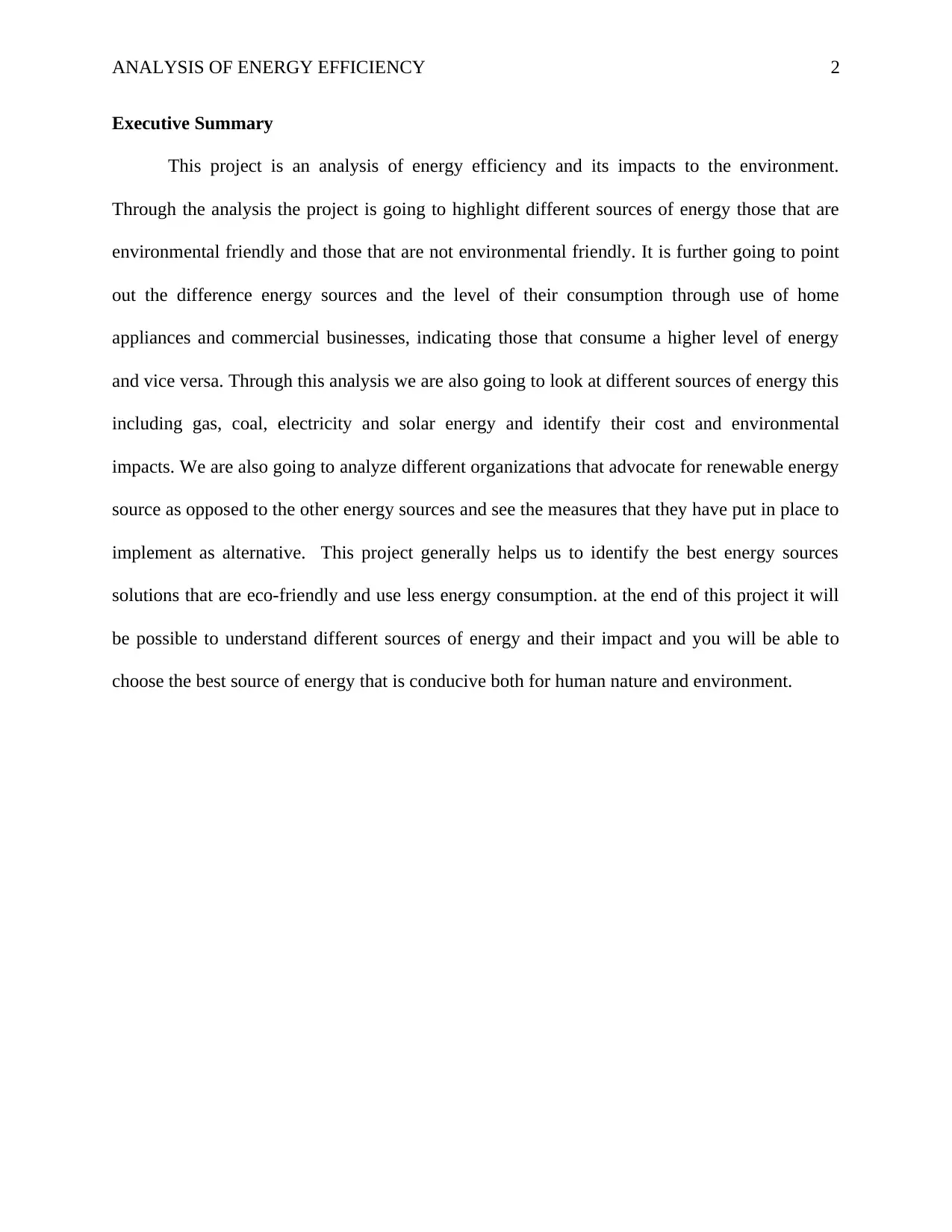
ANALYSIS OF ENERGY EFFICIENCY 2
Executive Summary
This project is an analysis of energy efficiency and its impacts to the environment.
Through the analysis the project is going to highlight different sources of energy those that are
environmental friendly and those that are not environmental friendly. It is further going to point
out the difference energy sources and the level of their consumption through use of home
appliances and commercial businesses, indicating those that consume a higher level of energy
and vice versa. Through this analysis we are also going to look at different sources of energy this
including gas, coal, electricity and solar energy and identify their cost and environmental
impacts. We are also going to analyze different organizations that advocate for renewable energy
source as opposed to the other energy sources and see the measures that they have put in place to
implement as alternative. This project generally helps us to identify the best energy sources
solutions that are eco-friendly and use less energy consumption. at the end of this project it will
be possible to understand different sources of energy and their impact and you will be able to
choose the best source of energy that is conducive both for human nature and environment.
Executive Summary
This project is an analysis of energy efficiency and its impacts to the environment.
Through the analysis the project is going to highlight different sources of energy those that are
environmental friendly and those that are not environmental friendly. It is further going to point
out the difference energy sources and the level of their consumption through use of home
appliances and commercial businesses, indicating those that consume a higher level of energy
and vice versa. Through this analysis we are also going to look at different sources of energy this
including gas, coal, electricity and solar energy and identify their cost and environmental
impacts. We are also going to analyze different organizations that advocate for renewable energy
source as opposed to the other energy sources and see the measures that they have put in place to
implement as alternative. This project generally helps us to identify the best energy sources
solutions that are eco-friendly and use less energy consumption. at the end of this project it will
be possible to understand different sources of energy and their impact and you will be able to
choose the best source of energy that is conducive both for human nature and environment.

ANALYSIS OF ENERGY EFFICIENCY 3
Analysis of Energy Efficiency
Introduction
People use energy every day for either cooking, transportation, heating and cooling,
manufacturers, entertainment and many others. Almost every household in Australia uses energy,
energy consumption vary from house hold to household. Energy is not only consumed in the
household but also in the industries, organizations, government institutions, schools and many
other places. It is through energy we are able to cook, use refrigerator, heaters, coolers, lighting
among other things. Energy use has really helped in for example in the households, in operating
different machineries like the vacuum cleaners, iron box, laundry among others. It is because of
the energy system that the machinery operates hence saving time. It is notably that different
institutions uses different amount of energy in their daily operations. The big institutions like
companies or industries use the most amount of energy compared to household energy
consumption. The more energy consumed the more capital is paid and vice versa. There are
several ways in which energy consumption can be reduced and also alternative remedies have
been put in place for the purpose of reducing energy consumption (Tiwari, Mishra & Royal
Society of Chemistry, 2012). Reduced energy consumption reduces the amount of carbon
dioxide gas emitted in the atmosphere hence reducing environmental pollution.
For the purpose of writing a better analysis of energy efficiency, I am going to use
observation method for data collection in my home to carry out a survey on the level of energy
consumption. I am using my home as the point of data collection because of the high
consumption of energy and this after the data collection I will be able to identify which
appliances leads to high energy consumption and find a remedy or a solution to reduce the level
of energy consumption in my home.
Analysis of Energy Efficiency
Introduction
People use energy every day for either cooking, transportation, heating and cooling,
manufacturers, entertainment and many others. Almost every household in Australia uses energy,
energy consumption vary from house hold to household. Energy is not only consumed in the
household but also in the industries, organizations, government institutions, schools and many
other places. It is through energy we are able to cook, use refrigerator, heaters, coolers, lighting
among other things. Energy use has really helped in for example in the households, in operating
different machineries like the vacuum cleaners, iron box, laundry among others. It is because of
the energy system that the machinery operates hence saving time. It is notably that different
institutions uses different amount of energy in their daily operations. The big institutions like
companies or industries use the most amount of energy compared to household energy
consumption. The more energy consumed the more capital is paid and vice versa. There are
several ways in which energy consumption can be reduced and also alternative remedies have
been put in place for the purpose of reducing energy consumption (Tiwari, Mishra & Royal
Society of Chemistry, 2012). Reduced energy consumption reduces the amount of carbon
dioxide gas emitted in the atmosphere hence reducing environmental pollution.
For the purpose of writing a better analysis of energy efficiency, I am going to use
observation method for data collection in my home to carry out a survey on the level of energy
consumption. I am using my home as the point of data collection because of the high
consumption of energy and this after the data collection I will be able to identify which
appliances leads to high energy consumption and find a remedy or a solution to reduce the level
of energy consumption in my home.
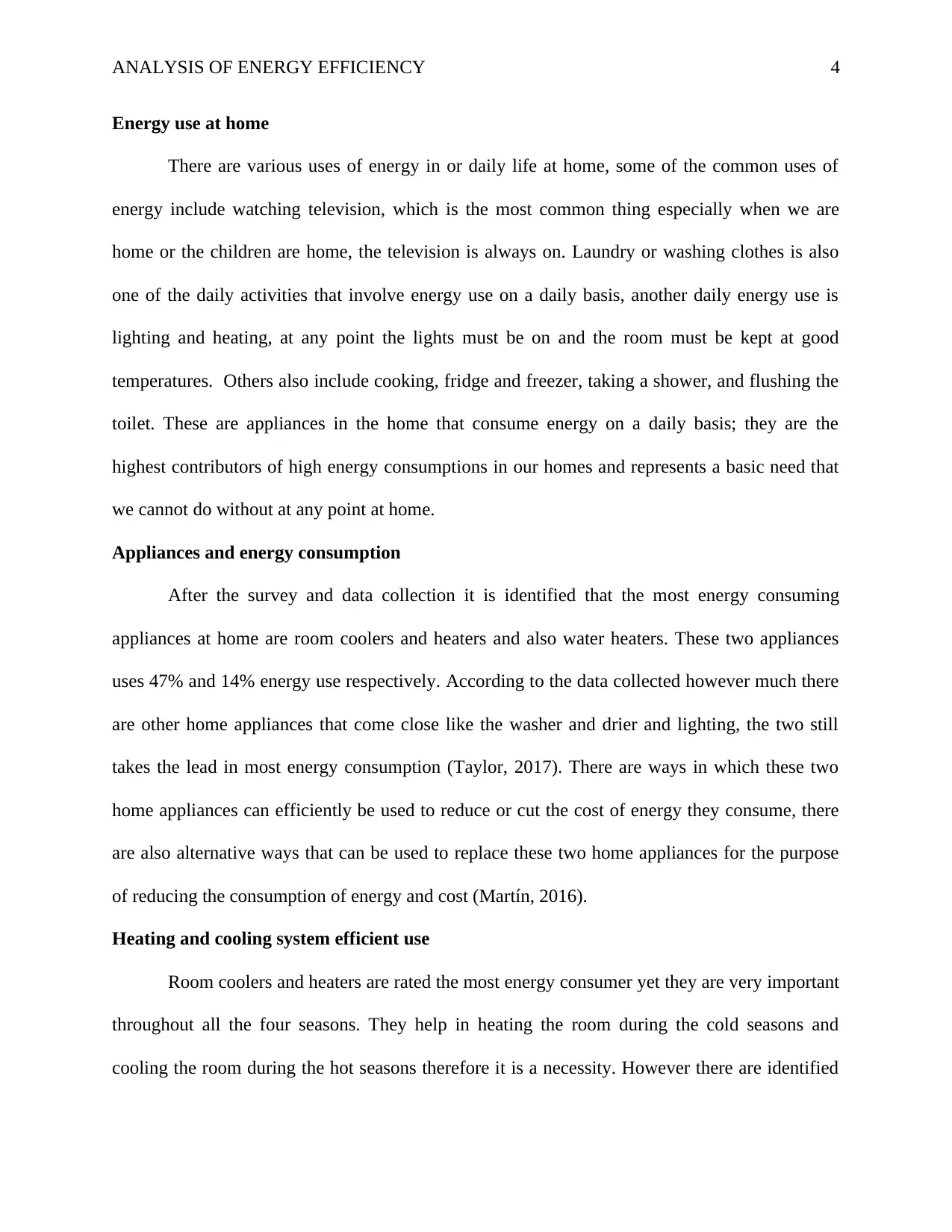
ANALYSIS OF ENERGY EFFICIENCY 4
Energy use at home
There are various uses of energy in or daily life at home, some of the common uses of
energy include watching television, which is the most common thing especially when we are
home or the children are home, the television is always on. Laundry or washing clothes is also
one of the daily activities that involve energy use on a daily basis, another daily energy use is
lighting and heating, at any point the lights must be on and the room must be kept at good
temperatures. Others also include cooking, fridge and freezer, taking a shower, and flushing the
toilet. These are appliances in the home that consume energy on a daily basis; they are the
highest contributors of high energy consumptions in our homes and represents a basic need that
we cannot do without at any point at home.
Appliances and energy consumption
After the survey and data collection it is identified that the most energy consuming
appliances at home are room coolers and heaters and also water heaters. These two appliances
uses 47% and 14% energy use respectively. According to the data collected however much there
are other home appliances that come close like the washer and drier and lighting, the two still
takes the lead in most energy consumption (Taylor, 2017). There are ways in which these two
home appliances can efficiently be used to reduce or cut the cost of energy they consume, there
are also alternative ways that can be used to replace these two home appliances for the purpose
of reducing the consumption of energy and cost (Martín, 2016) .
Heating and cooling system efficient use
Room coolers and heaters are rated the most energy consumer yet they are very important
throughout all the four seasons. They help in heating the room during the cold seasons and
cooling the room during the hot seasons therefore it is a necessity. However there are identified
Energy use at home
There are various uses of energy in or daily life at home, some of the common uses of
energy include watching television, which is the most common thing especially when we are
home or the children are home, the television is always on. Laundry or washing clothes is also
one of the daily activities that involve energy use on a daily basis, another daily energy use is
lighting and heating, at any point the lights must be on and the room must be kept at good
temperatures. Others also include cooking, fridge and freezer, taking a shower, and flushing the
toilet. These are appliances in the home that consume energy on a daily basis; they are the
highest contributors of high energy consumptions in our homes and represents a basic need that
we cannot do without at any point at home.
Appliances and energy consumption
After the survey and data collection it is identified that the most energy consuming
appliances at home are room coolers and heaters and also water heaters. These two appliances
uses 47% and 14% energy use respectively. According to the data collected however much there
are other home appliances that come close like the washer and drier and lighting, the two still
takes the lead in most energy consumption (Taylor, 2017). There are ways in which these two
home appliances can efficiently be used to reduce or cut the cost of energy they consume, there
are also alternative ways that can be used to replace these two home appliances for the purpose
of reducing the consumption of energy and cost (Martín, 2016) .
Heating and cooling system efficient use
Room coolers and heaters are rated the most energy consumer yet they are very important
throughout all the four seasons. They help in heating the room during the cold seasons and
cooling the room during the hot seasons therefore it is a necessity. However there are identified
Secure Best Marks with AI Grader
Need help grading? Try our AI Grader for instant feedback on your assignments.
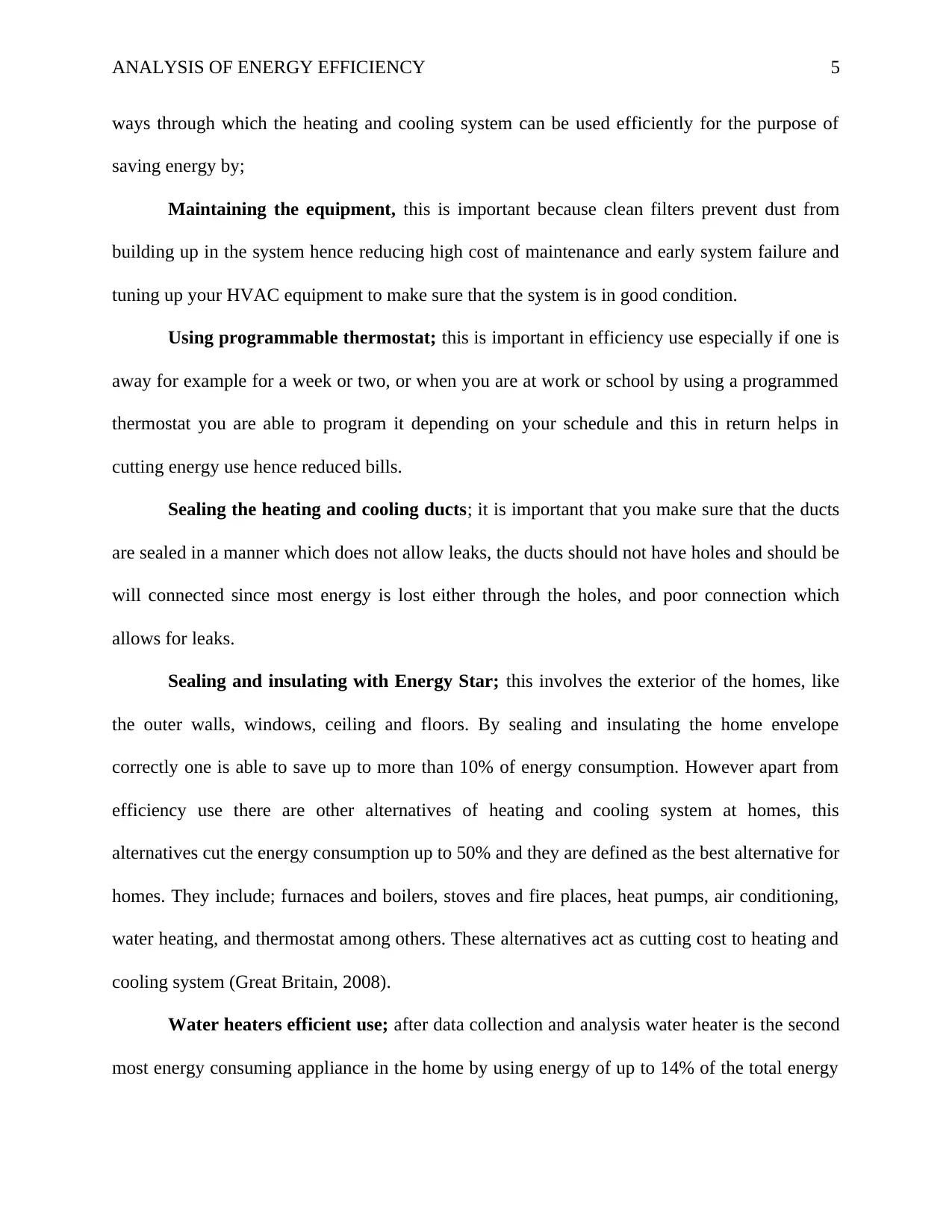
ANALYSIS OF ENERGY EFFICIENCY 5
ways through which the heating and cooling system can be used efficiently for the purpose of
saving energy by;
Maintaining the equipment, this is important because clean filters prevent dust from
building up in the system hence reducing high cost of maintenance and early system failure and
tuning up your HVAC equipment to make sure that the system is in good condition.
Using programmable thermostat; this is important in efficiency use especially if one is
away for example for a week or two, or when you are at work or school by using a programmed
thermostat you are able to program it depending on your schedule and this in return helps in
cutting energy use hence reduced bills.
Sealing the heating and cooling ducts; it is important that you make sure that the ducts
are sealed in a manner which does not allow leaks, the ducts should not have holes and should be
will connected since most energy is lost either through the holes, and poor connection which
allows for leaks.
Sealing and insulating with Energy Star; this involves the exterior of the homes, like
the outer walls, windows, ceiling and floors. By sealing and insulating the home envelope
correctly one is able to save up to more than 10% of energy consumption. However apart from
efficiency use there are other alternatives of heating and cooling system at homes, this
alternatives cut the energy consumption up to 50% and they are defined as the best alternative for
homes. They include; furnaces and boilers, stoves and fire places, heat pumps, air conditioning,
water heating, and thermostat among others. These alternatives act as cutting cost to heating and
cooling system (Great Britain, 2008).
Water heaters efficient use; after data collection and analysis water heater is the second
most energy consuming appliance in the home by using energy of up to 14% of the total energy
ways through which the heating and cooling system can be used efficiently for the purpose of
saving energy by;
Maintaining the equipment, this is important because clean filters prevent dust from
building up in the system hence reducing high cost of maintenance and early system failure and
tuning up your HVAC equipment to make sure that the system is in good condition.
Using programmable thermostat; this is important in efficiency use especially if one is
away for example for a week or two, or when you are at work or school by using a programmed
thermostat you are able to program it depending on your schedule and this in return helps in
cutting energy use hence reduced bills.
Sealing the heating and cooling ducts; it is important that you make sure that the ducts
are sealed in a manner which does not allow leaks, the ducts should not have holes and should be
will connected since most energy is lost either through the holes, and poor connection which
allows for leaks.
Sealing and insulating with Energy Star; this involves the exterior of the homes, like
the outer walls, windows, ceiling and floors. By sealing and insulating the home envelope
correctly one is able to save up to more than 10% of energy consumption. However apart from
efficiency use there are other alternatives of heating and cooling system at homes, this
alternatives cut the energy consumption up to 50% and they are defined as the best alternative for
homes. They include; furnaces and boilers, stoves and fire places, heat pumps, air conditioning,
water heating, and thermostat among others. These alternatives act as cutting cost to heating and
cooling system (Great Britain, 2008).
Water heaters efficient use; after data collection and analysis water heater is the second
most energy consuming appliance in the home by using energy of up to 14% of the total energy
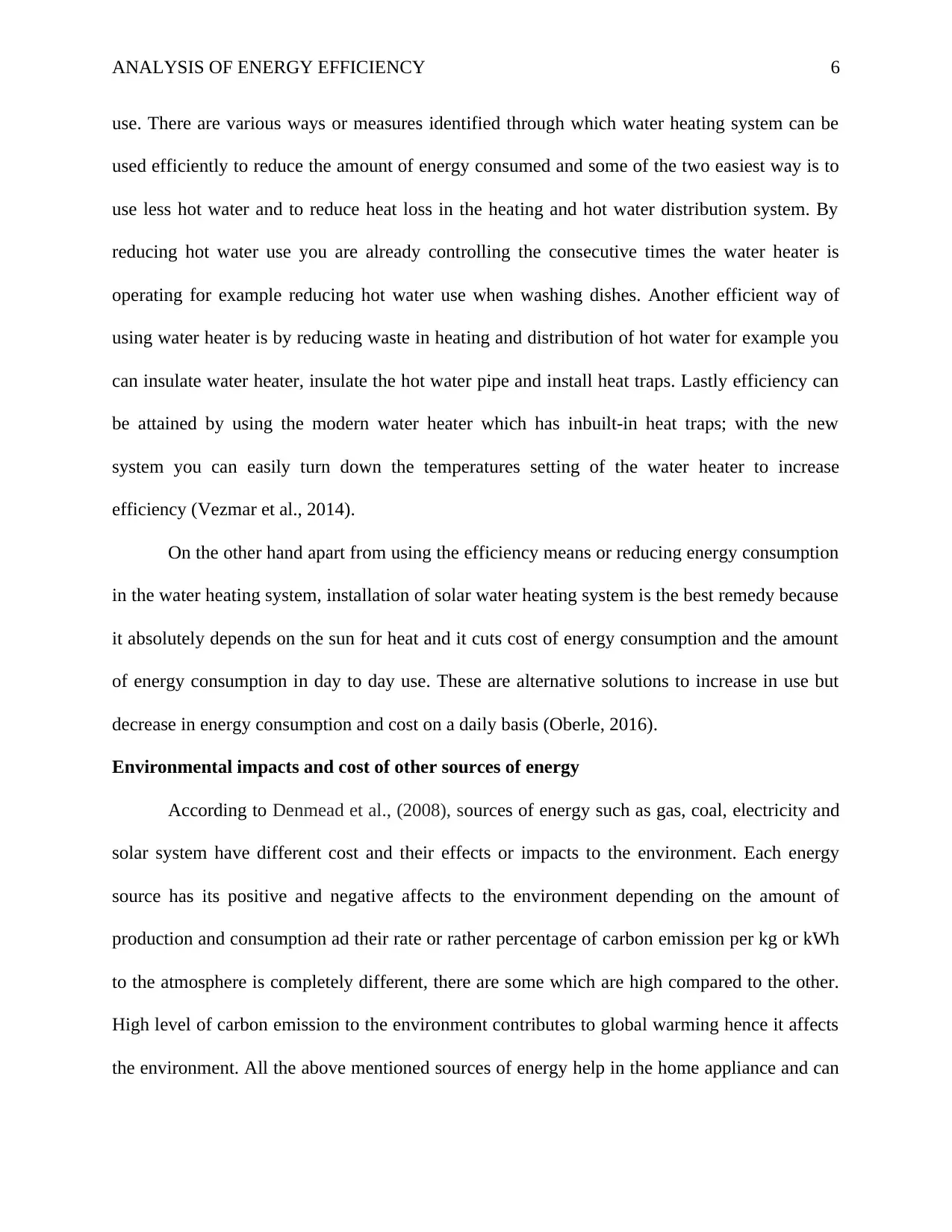
ANALYSIS OF ENERGY EFFICIENCY 6
use. There are various ways or measures identified through which water heating system can be
used efficiently to reduce the amount of energy consumed and some of the two easiest way is to
use less hot water and to reduce heat loss in the heating and hot water distribution system. By
reducing hot water use you are already controlling the consecutive times the water heater is
operating for example reducing hot water use when washing dishes. Another efficient way of
using water heater is by reducing waste in heating and distribution of hot water for example you
can insulate water heater, insulate the hot water pipe and install heat traps. Lastly efficiency can
be attained by using the modern water heater which has inbuilt-in heat traps; with the new
system you can easily turn down the temperatures setting of the water heater to increase
efficiency (Vezmar et al., 2014).
On the other hand apart from using the efficiency means or reducing energy consumption
in the water heating system, installation of solar water heating system is the best remedy because
it absolutely depends on the sun for heat and it cuts cost of energy consumption and the amount
of energy consumption in day to day use. These are alternative solutions to increase in use but
decrease in energy consumption and cost on a daily basis (Oberle, 2016).
Environmental impacts and cost of other sources of energy
According to Denmead et al., (2008), sources of energy such as gas, coal, electricity and
solar system have different cost and their effects or impacts to the environment. Each energy
source has its positive and negative affects to the environment depending on the amount of
production and consumption ad their rate or rather percentage of carbon emission per kg or kWh
to the atmosphere is completely different, there are some which are high compared to the other.
High level of carbon emission to the environment contributes to global warming hence it affects
the environment. All the above mentioned sources of energy help in the home appliance and can
use. There are various ways or measures identified through which water heating system can be
used efficiently to reduce the amount of energy consumed and some of the two easiest way is to
use less hot water and to reduce heat loss in the heating and hot water distribution system. By
reducing hot water use you are already controlling the consecutive times the water heater is
operating for example reducing hot water use when washing dishes. Another efficient way of
using water heater is by reducing waste in heating and distribution of hot water for example you
can insulate water heater, insulate the hot water pipe and install heat traps. Lastly efficiency can
be attained by using the modern water heater which has inbuilt-in heat traps; with the new
system you can easily turn down the temperatures setting of the water heater to increase
efficiency (Vezmar et al., 2014).
On the other hand apart from using the efficiency means or reducing energy consumption
in the water heating system, installation of solar water heating system is the best remedy because
it absolutely depends on the sun for heat and it cuts cost of energy consumption and the amount
of energy consumption in day to day use. These are alternative solutions to increase in use but
decrease in energy consumption and cost on a daily basis (Oberle, 2016).
Environmental impacts and cost of other sources of energy
According to Denmead et al., (2008), sources of energy such as gas, coal, electricity and
solar system have different cost and their effects or impacts to the environment. Each energy
source has its positive and negative affects to the environment depending on the amount of
production and consumption ad their rate or rather percentage of carbon emission per kg or kWh
to the atmosphere is completely different, there are some which are high compared to the other.
High level of carbon emission to the environment contributes to global warming hence it affects
the environment. All the above mentioned sources of energy help in the home appliance and can
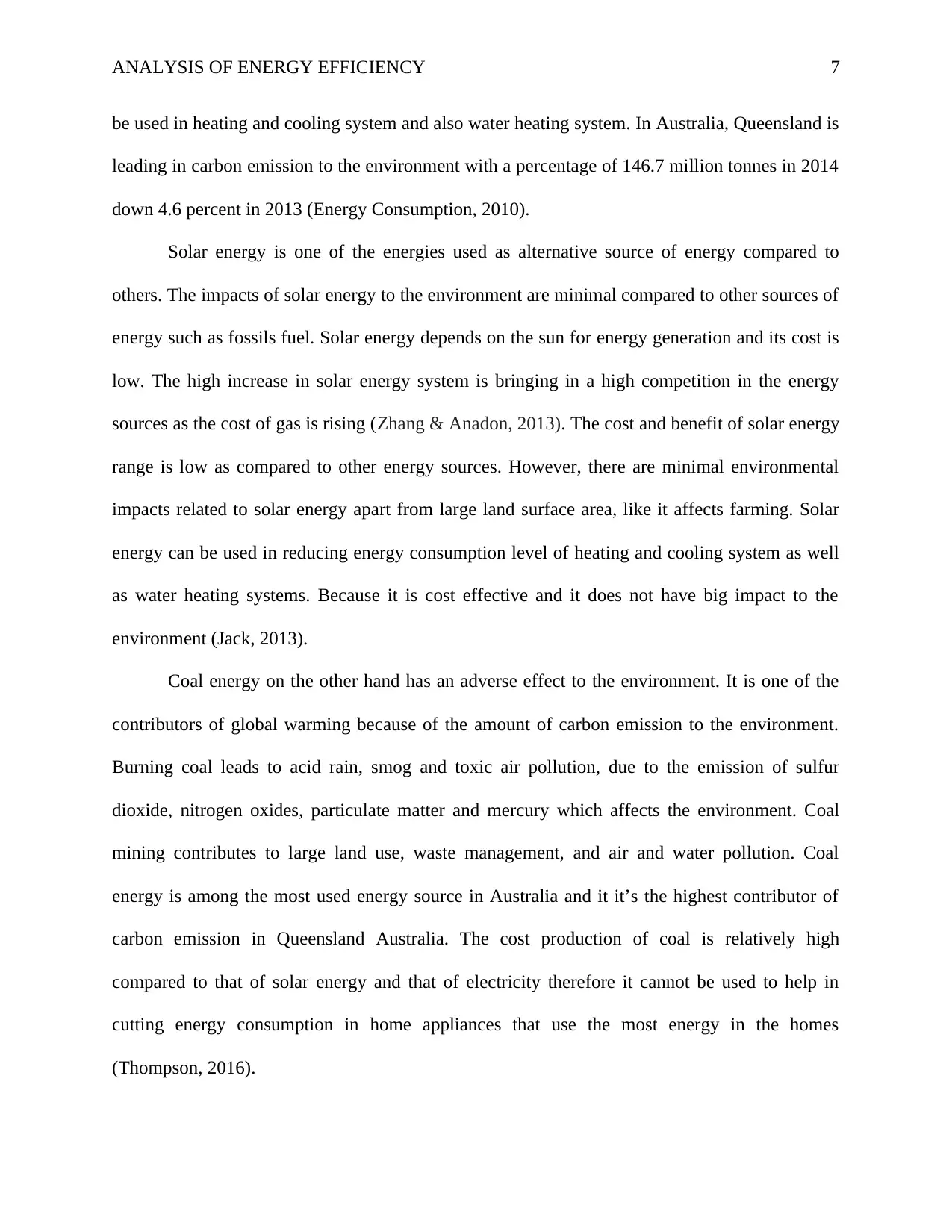
ANALYSIS OF ENERGY EFFICIENCY 7
be used in heating and cooling system and also water heating system. In Australia, Queensland is
leading in carbon emission to the environment with a percentage of 146.7 million tonnes in 2014
down 4.6 percent in 2013 (Energy Consumption, 2010).
Solar energy is one of the energies used as alternative source of energy compared to
others. The impacts of solar energy to the environment are minimal compared to other sources of
energy such as fossils fuel. Solar energy depends on the sun for energy generation and its cost is
low. The high increase in solar energy system is bringing in a high competition in the energy
sources as the cost of gas is rising (Zhang & Anadon, 2013). The cost and benefit of solar energy
range is low as compared to other energy sources. However, there are minimal environmental
impacts related to solar energy apart from large land surface area, like it affects farming. Solar
energy can be used in reducing energy consumption level of heating and cooling system as well
as water heating systems. Because it is cost effective and it does not have big impact to the
environment (Jack, 2013).
Coal energy on the other hand has an adverse effect to the environment. It is one of the
contributors of global warming because of the amount of carbon emission to the environment.
Burning coal leads to acid rain, smog and toxic air pollution, due to the emission of sulfur
dioxide, nitrogen oxides, particulate matter and mercury which affects the environment. Coal
mining contributes to large land use, waste management, and air and water pollution. Coal
energy is among the most used energy source in Australia and it it’s the highest contributor of
carbon emission in Queensland Australia. The cost production of coal is relatively high
compared to that of solar energy and that of electricity therefore it cannot be used to help in
cutting energy consumption in home appliances that use the most energy in the homes
(Thompson, 2016).
be used in heating and cooling system and also water heating system. In Australia, Queensland is
leading in carbon emission to the environment with a percentage of 146.7 million tonnes in 2014
down 4.6 percent in 2013 (Energy Consumption, 2010).
Solar energy is one of the energies used as alternative source of energy compared to
others. The impacts of solar energy to the environment are minimal compared to other sources of
energy such as fossils fuel. Solar energy depends on the sun for energy generation and its cost is
low. The high increase in solar energy system is bringing in a high competition in the energy
sources as the cost of gas is rising (Zhang & Anadon, 2013). The cost and benefit of solar energy
range is low as compared to other energy sources. However, there are minimal environmental
impacts related to solar energy apart from large land surface area, like it affects farming. Solar
energy can be used in reducing energy consumption level of heating and cooling system as well
as water heating systems. Because it is cost effective and it does not have big impact to the
environment (Jack, 2013).
Coal energy on the other hand has an adverse effect to the environment. It is one of the
contributors of global warming because of the amount of carbon emission to the environment.
Burning coal leads to acid rain, smog and toxic air pollution, due to the emission of sulfur
dioxide, nitrogen oxides, particulate matter and mercury which affects the environment. Coal
mining contributes to large land use, waste management, and air and water pollution. Coal
energy is among the most used energy source in Australia and it it’s the highest contributor of
carbon emission in Queensland Australia. The cost production of coal is relatively high
compared to that of solar energy and that of electricity therefore it cannot be used to help in
cutting energy consumption in home appliances that use the most energy in the homes
(Thompson, 2016).
Paraphrase This Document
Need a fresh take? Get an instant paraphrase of this document with our AI Paraphraser
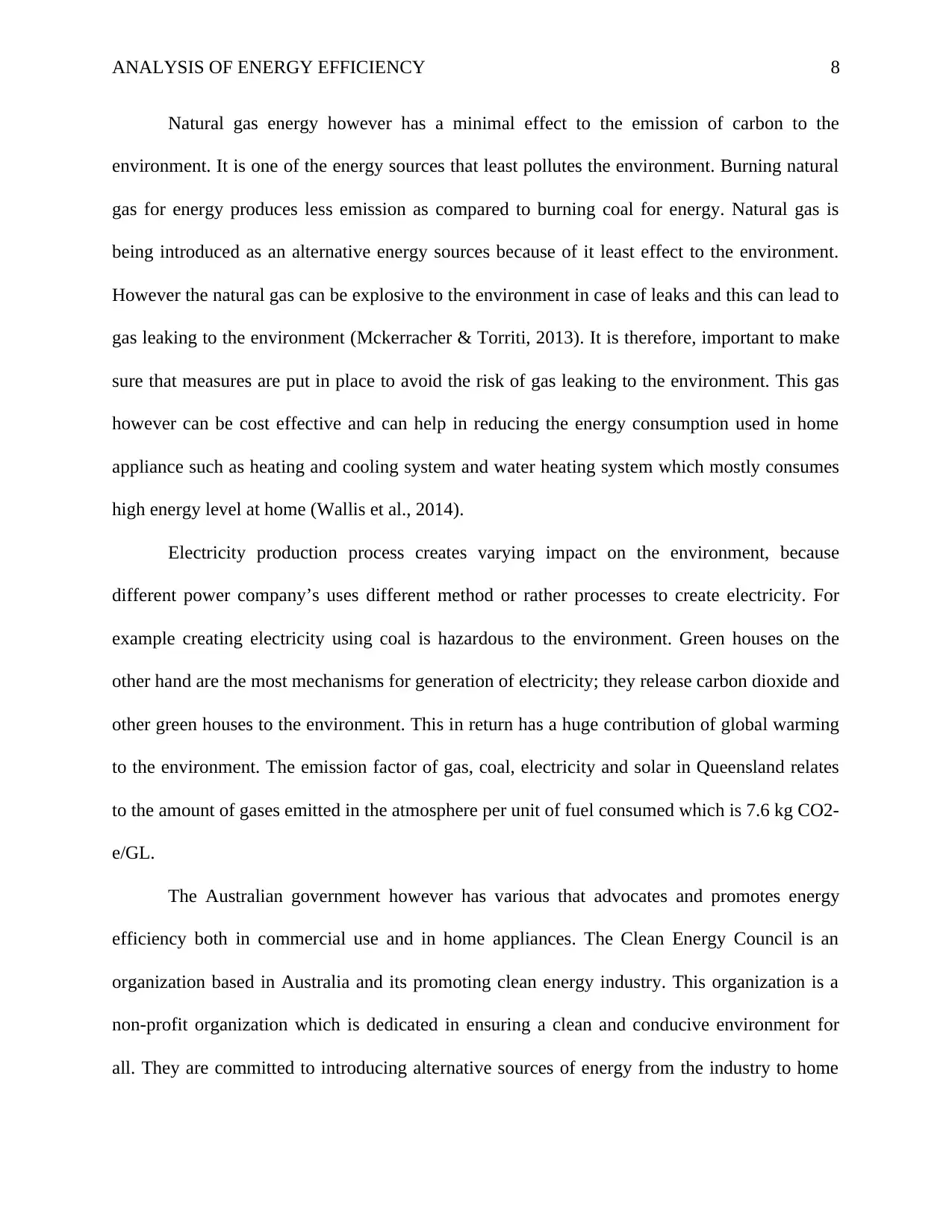
ANALYSIS OF ENERGY EFFICIENCY 8
Natural gas energy however has a minimal effect to the emission of carbon to the
environment. It is one of the energy sources that least pollutes the environment. Burning natural
gas for energy produces less emission as compared to burning coal for energy. Natural gas is
being introduced as an alternative energy sources because of it least effect to the environment.
However the natural gas can be explosive to the environment in case of leaks and this can lead to
gas leaking to the environment (Mckerracher & Torriti, 2013). It is therefore, important to make
sure that measures are put in place to avoid the risk of gas leaking to the environment. This gas
however can be cost effective and can help in reducing the energy consumption used in home
appliance such as heating and cooling system and water heating system which mostly consumes
high energy level at home (Wallis et al., 2014).
Electricity production process creates varying impact on the environment, because
different power company’s uses different method or rather processes to create electricity. For
example creating electricity using coal is hazardous to the environment. Green houses on the
other hand are the most mechanisms for generation of electricity; they release carbon dioxide and
other green houses to the environment. This in return has a huge contribution of global warming
to the environment. The emission factor of gas, coal, electricity and solar in Queensland relates
to the amount of gases emitted in the atmosphere per unit of fuel consumed which is 7.6 kg CO2-
e/GL.
The Australian government however has various that advocates and promotes energy
efficiency both in commercial use and in home appliances. The Clean Energy Council is an
organization based in Australia and its promoting clean energy industry. This organization is a
non-profit organization which is dedicated in ensuring a clean and conducive environment for
all. They are committed to introducing alternative sources of energy from the industry to home
Natural gas energy however has a minimal effect to the emission of carbon to the
environment. It is one of the energy sources that least pollutes the environment. Burning natural
gas for energy produces less emission as compared to burning coal for energy. Natural gas is
being introduced as an alternative energy sources because of it least effect to the environment.
However the natural gas can be explosive to the environment in case of leaks and this can lead to
gas leaking to the environment (Mckerracher & Torriti, 2013). It is therefore, important to make
sure that measures are put in place to avoid the risk of gas leaking to the environment. This gas
however can be cost effective and can help in reducing the energy consumption used in home
appliance such as heating and cooling system and water heating system which mostly consumes
high energy level at home (Wallis et al., 2014).
Electricity production process creates varying impact on the environment, because
different power company’s uses different method or rather processes to create electricity. For
example creating electricity using coal is hazardous to the environment. Green houses on the
other hand are the most mechanisms for generation of electricity; they release carbon dioxide and
other green houses to the environment. This in return has a huge contribution of global warming
to the environment. The emission factor of gas, coal, electricity and solar in Queensland relates
to the amount of gases emitted in the atmosphere per unit of fuel consumed which is 7.6 kg CO2-
e/GL.
The Australian government however has various that advocates and promotes energy
efficiency both in commercial use and in home appliances. The Clean Energy Council is an
organization based in Australia and its promoting clean energy industry. This organization is a
non-profit organization which is dedicated in ensuring a clean and conducive environment for
all. They are committed to introducing alternative sources of energy from the industry to home
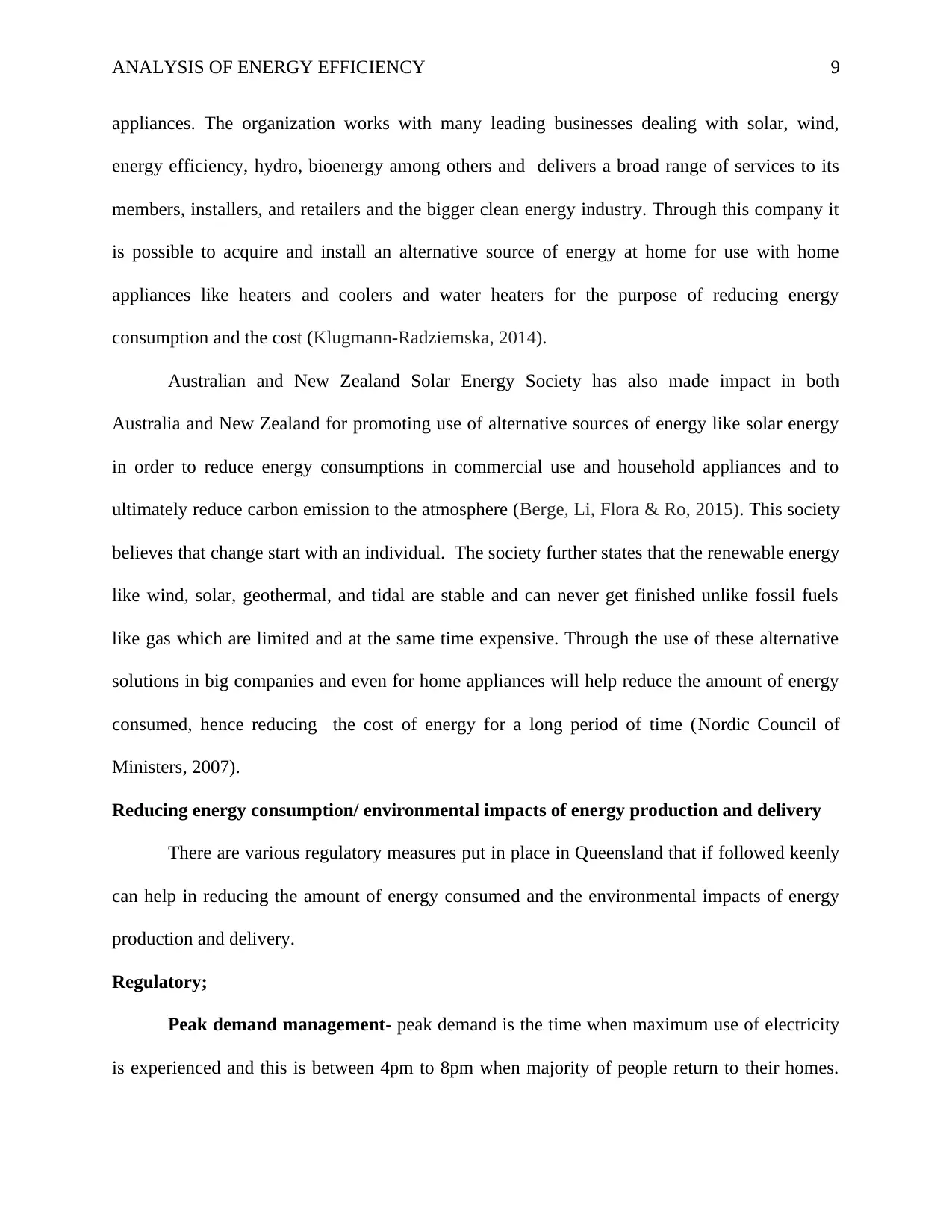
ANALYSIS OF ENERGY EFFICIENCY 9
appliances. The organization works with many leading businesses dealing with solar, wind,
energy efficiency, hydro, bioenergy among others and delivers a broad range of services to its
members, installers, and retailers and the bigger clean energy industry. Through this company it
is possible to acquire and install an alternative source of energy at home for use with home
appliances like heaters and coolers and water heaters for the purpose of reducing energy
consumption and the cost (Klugmann-Radziemska, 2014).
Australian and New Zealand Solar Energy Society has also made impact in both
Australia and New Zealand for promoting use of alternative sources of energy like solar energy
in order to reduce energy consumptions in commercial use and household appliances and to
ultimately reduce carbon emission to the atmosphere (Berge, Li, Flora & Ro, 2015). This society
believes that change start with an individual. The society further states that the renewable energy
like wind, solar, geothermal, and tidal are stable and can never get finished unlike fossil fuels
like gas which are limited and at the same time expensive. Through the use of these alternative
solutions in big companies and even for home appliances will help reduce the amount of energy
consumed, hence reducing the cost of energy for a long period of time (Nordic Council of
Ministers, 2007).
Reducing energy consumption/ environmental impacts of energy production and delivery
There are various regulatory measures put in place in Queensland that if followed keenly
can help in reducing the amount of energy consumed and the environmental impacts of energy
production and delivery.
Regulatory;
Peak demand management- peak demand is the time when maximum use of electricity
is experienced and this is between 4pm to 8pm when majority of people return to their homes.
appliances. The organization works with many leading businesses dealing with solar, wind,
energy efficiency, hydro, bioenergy among others and delivers a broad range of services to its
members, installers, and retailers and the bigger clean energy industry. Through this company it
is possible to acquire and install an alternative source of energy at home for use with home
appliances like heaters and coolers and water heaters for the purpose of reducing energy
consumption and the cost (Klugmann-Radziemska, 2014).
Australian and New Zealand Solar Energy Society has also made impact in both
Australia and New Zealand for promoting use of alternative sources of energy like solar energy
in order to reduce energy consumptions in commercial use and household appliances and to
ultimately reduce carbon emission to the atmosphere (Berge, Li, Flora & Ro, 2015). This society
believes that change start with an individual. The society further states that the renewable energy
like wind, solar, geothermal, and tidal are stable and can never get finished unlike fossil fuels
like gas which are limited and at the same time expensive. Through the use of these alternative
solutions in big companies and even for home appliances will help reduce the amount of energy
consumed, hence reducing the cost of energy for a long period of time (Nordic Council of
Ministers, 2007).
Reducing energy consumption/ environmental impacts of energy production and delivery
There are various regulatory measures put in place in Queensland that if followed keenly
can help in reducing the amount of energy consumed and the environmental impacts of energy
production and delivery.
Regulatory;
Peak demand management- peak demand is the time when maximum use of electricity
is experienced and this is between 4pm to 8pm when majority of people return to their homes.
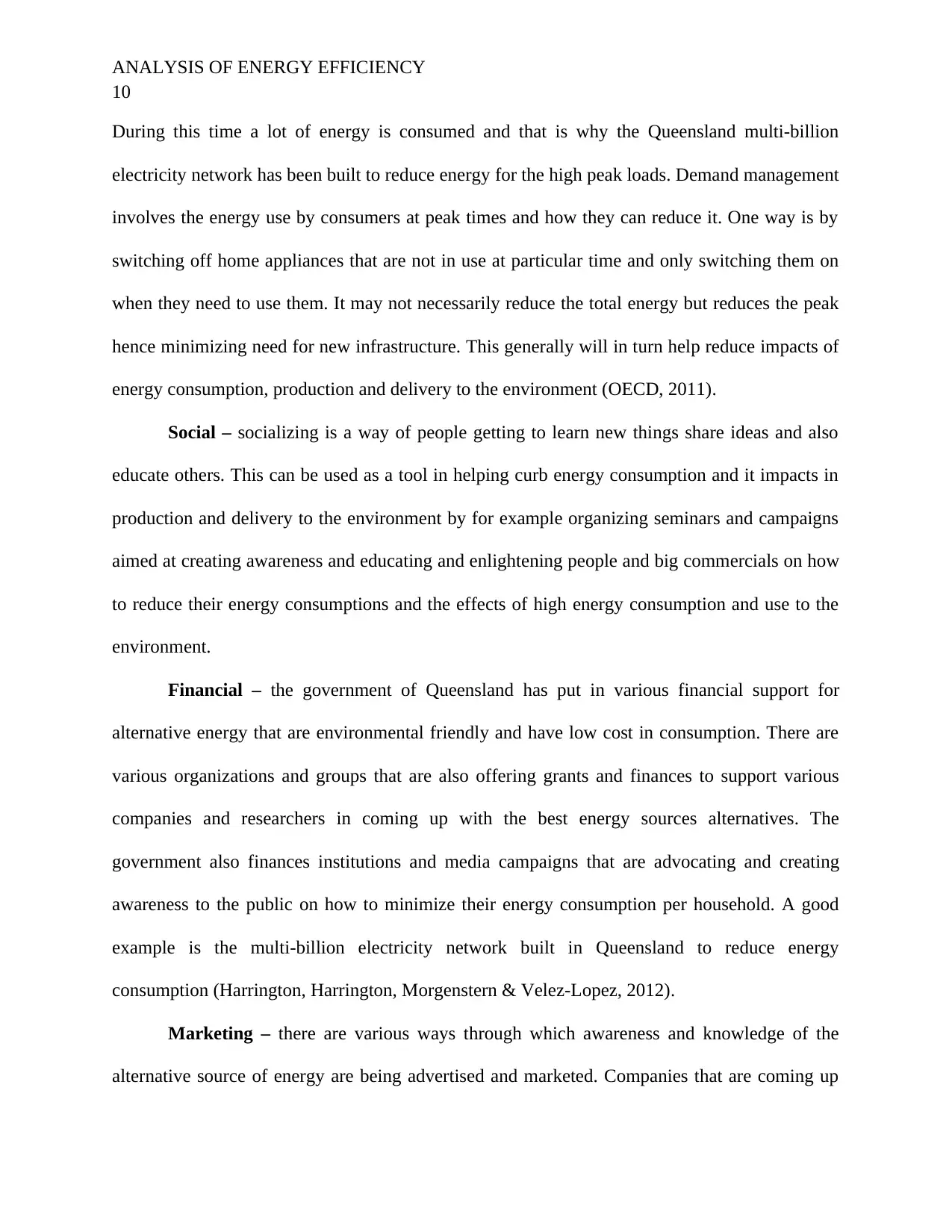
ANALYSIS OF ENERGY EFFICIENCY
10
During this time a lot of energy is consumed and that is why the Queensland multi-billion
electricity network has been built to reduce energy for the high peak loads. Demand management
involves the energy use by consumers at peak times and how they can reduce it. One way is by
switching off home appliances that are not in use at particular time and only switching them on
when they need to use them. It may not necessarily reduce the total energy but reduces the peak
hence minimizing need for new infrastructure. This generally will in turn help reduce impacts of
energy consumption, production and delivery to the environment (OECD, 2011).
Social – socializing is a way of people getting to learn new things share ideas and also
educate others. This can be used as a tool in helping curb energy consumption and it impacts in
production and delivery to the environment by for example organizing seminars and campaigns
aimed at creating awareness and educating and enlightening people and big commercials on how
to reduce their energy consumptions and the effects of high energy consumption and use to the
environment.
Financial – the government of Queensland has put in various financial support for
alternative energy that are environmental friendly and have low cost in consumption. There are
various organizations and groups that are also offering grants and finances to support various
companies and researchers in coming up with the best energy sources alternatives. The
government also finances institutions and media campaigns that are advocating and creating
awareness to the public on how to minimize their energy consumption per household. A good
example is the multi-billion electricity network built in Queensland to reduce energy
consumption (Harrington, Harrington, Morgenstern & Velez-Lopez, 2012).
Marketing – there are various ways through which awareness and knowledge of the
alternative source of energy are being advertised and marketed. Companies that are coming up
10
During this time a lot of energy is consumed and that is why the Queensland multi-billion
electricity network has been built to reduce energy for the high peak loads. Demand management
involves the energy use by consumers at peak times and how they can reduce it. One way is by
switching off home appliances that are not in use at particular time and only switching them on
when they need to use them. It may not necessarily reduce the total energy but reduces the peak
hence minimizing need for new infrastructure. This generally will in turn help reduce impacts of
energy consumption, production and delivery to the environment (OECD, 2011).
Social – socializing is a way of people getting to learn new things share ideas and also
educate others. This can be used as a tool in helping curb energy consumption and it impacts in
production and delivery to the environment by for example organizing seminars and campaigns
aimed at creating awareness and educating and enlightening people and big commercials on how
to reduce their energy consumptions and the effects of high energy consumption and use to the
environment.
Financial – the government of Queensland has put in various financial support for
alternative energy that are environmental friendly and have low cost in consumption. There are
various organizations and groups that are also offering grants and finances to support various
companies and researchers in coming up with the best energy sources alternatives. The
government also finances institutions and media campaigns that are advocating and creating
awareness to the public on how to minimize their energy consumption per household. A good
example is the multi-billion electricity network built in Queensland to reduce energy
consumption (Harrington, Harrington, Morgenstern & Velez-Lopez, 2012).
Marketing – there are various ways through which awareness and knowledge of the
alternative source of energy are being advertised and marketed. Companies that are coming up
Secure Best Marks with AI Grader
Need help grading? Try our AI Grader for instant feedback on your assignments.
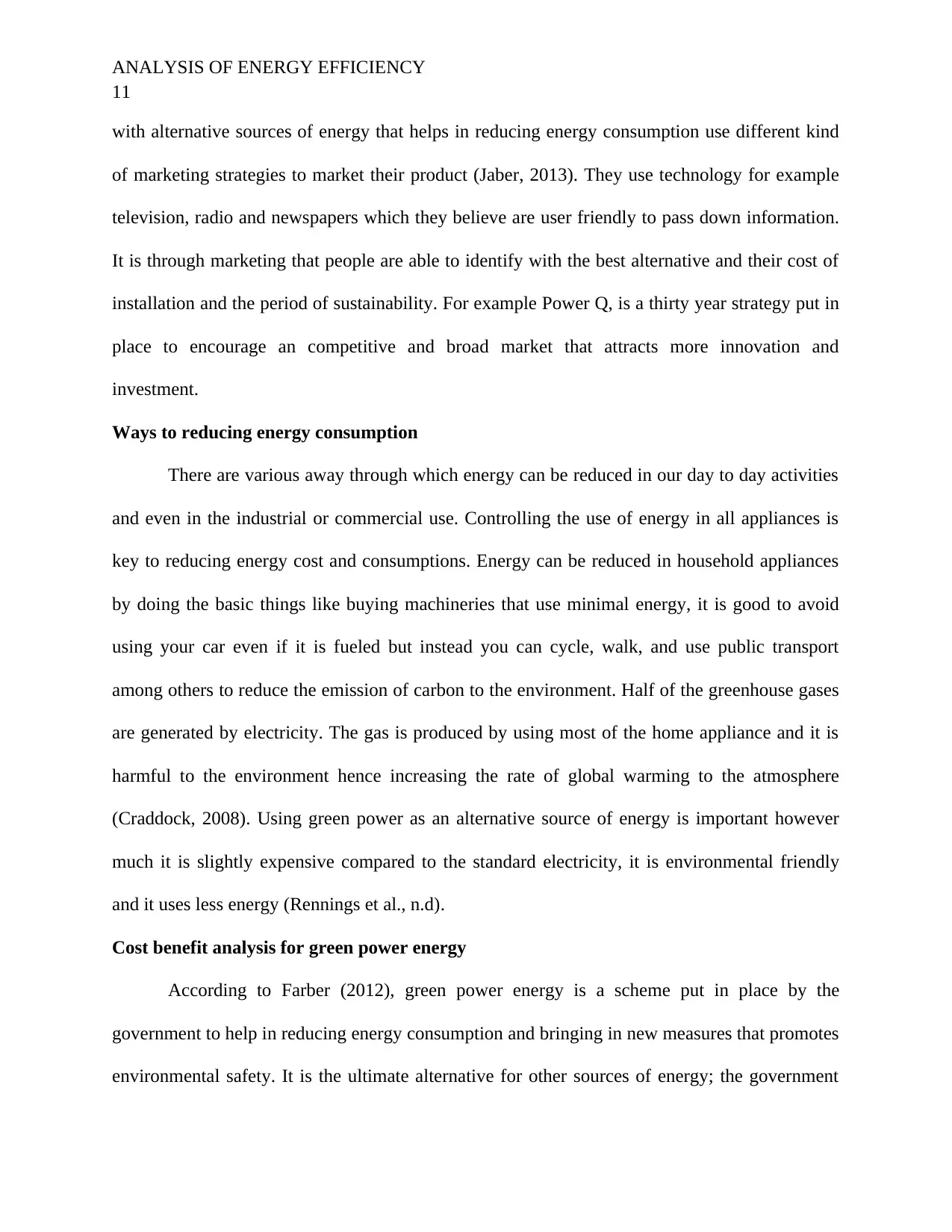
ANALYSIS OF ENERGY EFFICIENCY
11
with alternative sources of energy that helps in reducing energy consumption use different kind
of marketing strategies to market their product (Jaber, 2013). They use technology for example
television, radio and newspapers which they believe are user friendly to pass down information.
It is through marketing that people are able to identify with the best alternative and their cost of
installation and the period of sustainability. For example Power Q, is a thirty year strategy put in
place to encourage an competitive and broad market that attracts more innovation and
investment.
Ways to reducing energy consumption
There are various away through which energy can be reduced in our day to day activities
and even in the industrial or commercial use. Controlling the use of energy in all appliances is
key to reducing energy cost and consumptions. Energy can be reduced in household appliances
by doing the basic things like buying machineries that use minimal energy, it is good to avoid
using your car even if it is fueled but instead you can cycle, walk, and use public transport
among others to reduce the emission of carbon to the environment. Half of the greenhouse gases
are generated by electricity. The gas is produced by using most of the home appliance and it is
harmful to the environment hence increasing the rate of global warming to the atmosphere
(Craddock, 2008). Using green power as an alternative source of energy is important however
much it is slightly expensive compared to the standard electricity, it is environmental friendly
and it uses less energy (Rennings et al., n.d).
Cost benefit analysis for green power energy
According to Farber (2012), green power energy is a scheme put in place by the
government to help in reducing energy consumption and bringing in new measures that promotes
environmental safety. It is the ultimate alternative for other sources of energy; the government
11
with alternative sources of energy that helps in reducing energy consumption use different kind
of marketing strategies to market their product (Jaber, 2013). They use technology for example
television, radio and newspapers which they believe are user friendly to pass down information.
It is through marketing that people are able to identify with the best alternative and their cost of
installation and the period of sustainability. For example Power Q, is a thirty year strategy put in
place to encourage an competitive and broad market that attracts more innovation and
investment.
Ways to reducing energy consumption
There are various away through which energy can be reduced in our day to day activities
and even in the industrial or commercial use. Controlling the use of energy in all appliances is
key to reducing energy cost and consumptions. Energy can be reduced in household appliances
by doing the basic things like buying machineries that use minimal energy, it is good to avoid
using your car even if it is fueled but instead you can cycle, walk, and use public transport
among others to reduce the emission of carbon to the environment. Half of the greenhouse gases
are generated by electricity. The gas is produced by using most of the home appliance and it is
harmful to the environment hence increasing the rate of global warming to the atmosphere
(Craddock, 2008). Using green power as an alternative source of energy is important however
much it is slightly expensive compared to the standard electricity, it is environmental friendly
and it uses less energy (Rennings et al., n.d).
Cost benefit analysis for green power energy
According to Farber (2012), green power energy is a scheme put in place by the
government to help in reducing energy consumption and bringing in new measures that promotes
environmental safety. It is the ultimate alternative for other sources of energy; the government
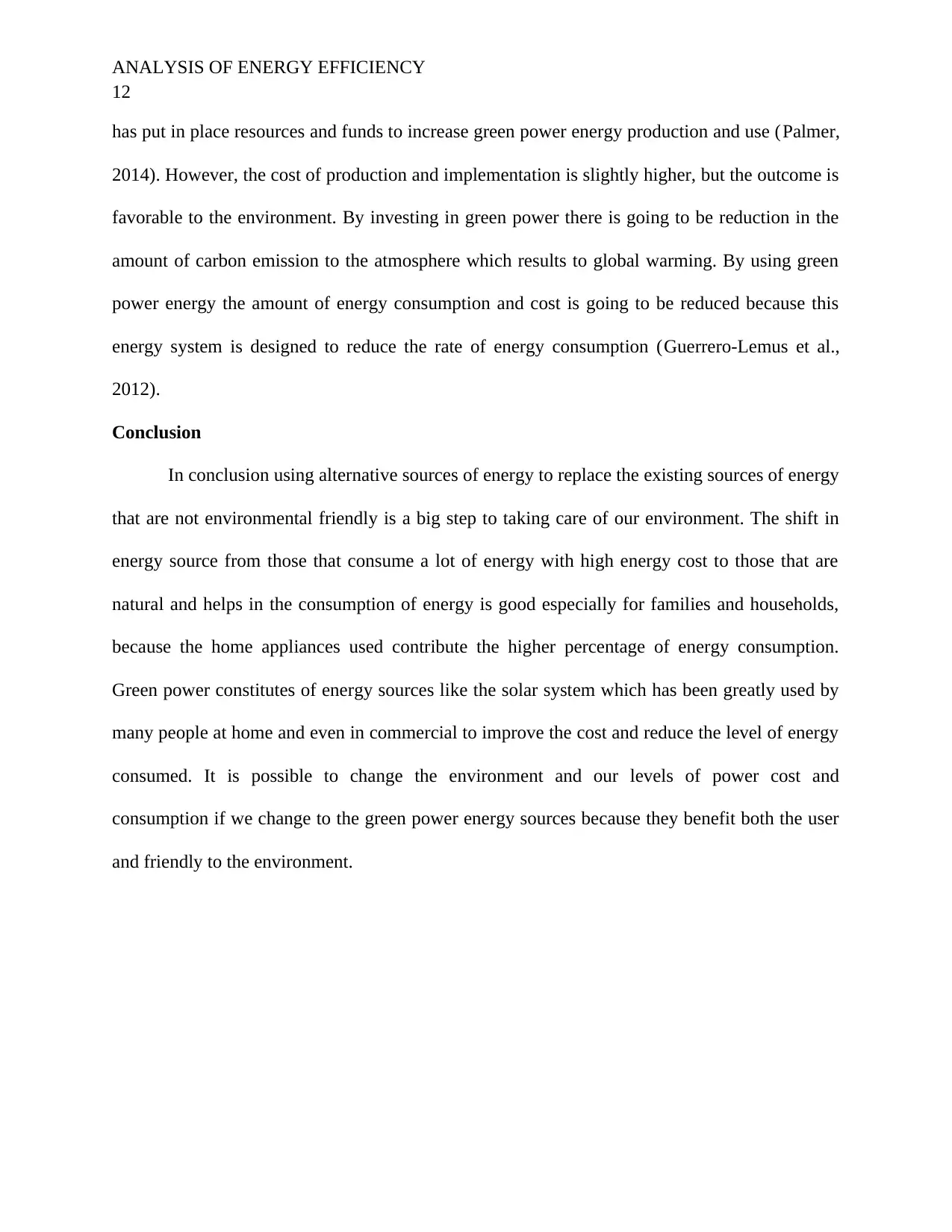
ANALYSIS OF ENERGY EFFICIENCY
12
has put in place resources and funds to increase green power energy production and use (Palmer,
2014). However, the cost of production and implementation is slightly higher, but the outcome is
favorable to the environment. By investing in green power there is going to be reduction in the
amount of carbon emission to the atmosphere which results to global warming. By using green
power energy the amount of energy consumption and cost is going to be reduced because this
energy system is designed to reduce the rate of energy consumption (Guerrero-Lemus et al.,
2012).
Conclusion
In conclusion using alternative sources of energy to replace the existing sources of energy
that are not environmental friendly is a big step to taking care of our environment. The shift in
energy source from those that consume a lot of energy with high energy cost to those that are
natural and helps in the consumption of energy is good especially for families and households,
because the home appliances used contribute the higher percentage of energy consumption.
Green power constitutes of energy sources like the solar system which has been greatly used by
many people at home and even in commercial to improve the cost and reduce the level of energy
consumed. It is possible to change the environment and our levels of power cost and
consumption if we change to the green power energy sources because they benefit both the user
and friendly to the environment.
12
has put in place resources and funds to increase green power energy production and use (Palmer,
2014). However, the cost of production and implementation is slightly higher, but the outcome is
favorable to the environment. By investing in green power there is going to be reduction in the
amount of carbon emission to the atmosphere which results to global warming. By using green
power energy the amount of energy consumption and cost is going to be reduced because this
energy system is designed to reduce the rate of energy consumption (Guerrero-Lemus et al.,
2012).
Conclusion
In conclusion using alternative sources of energy to replace the existing sources of energy
that are not environmental friendly is a big step to taking care of our environment. The shift in
energy source from those that consume a lot of energy with high energy cost to those that are
natural and helps in the consumption of energy is good especially for families and households,
because the home appliances used contribute the higher percentage of energy consumption.
Green power constitutes of energy sources like the solar system which has been greatly used by
many people at home and even in commercial to improve the cost and reduce the level of energy
consumed. It is possible to change the environment and our levels of power cost and
consumption if we change to the green power energy sources because they benefit both the user
and friendly to the environment.
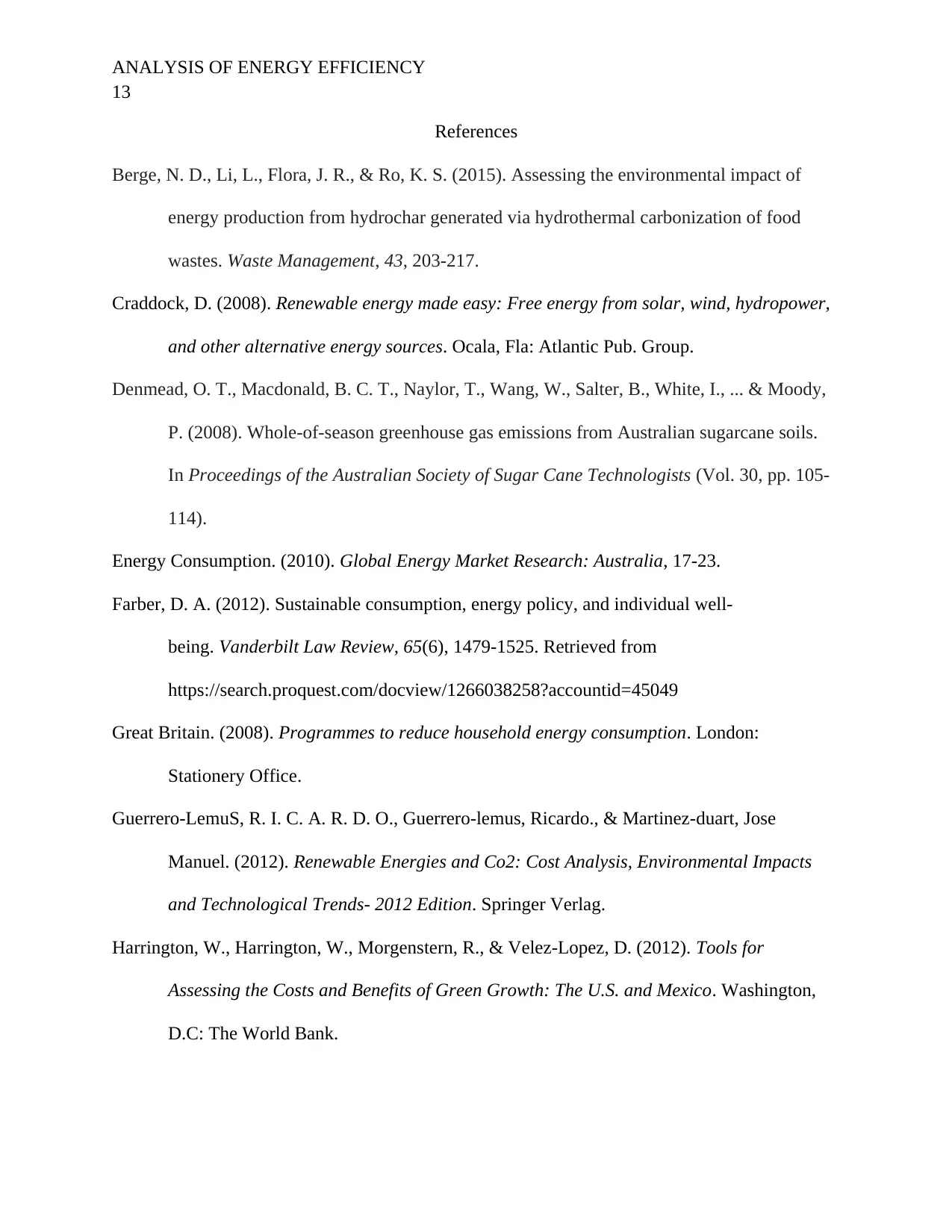
ANALYSIS OF ENERGY EFFICIENCY
13
References
Berge, N. D., Li, L., Flora, J. R., & Ro, K. S. (2015). Assessing the environmental impact of
energy production from hydrochar generated via hydrothermal carbonization of food
wastes. Waste Management, 43, 203-217.
Craddock, D. (2008). Renewable energy made easy: Free energy from solar, wind, hydropower,
and other alternative energy sources. Ocala, Fla: Atlantic Pub. Group.
Denmead, O. T., Macdonald, B. C. T., Naylor, T., Wang, W., Salter, B., White, I., ... & Moody,
P. (2008). Whole-of-season greenhouse gas emissions from Australian sugarcane soils.
In Proceedings of the Australian Society of Sugar Cane Technologists (Vol. 30, pp. 105-
114).
Energy Consumption. (2010). Global Energy Market Research: Australia, 17-23.
Farber, D. A. (2012). Sustainable consumption, energy policy, and individual well-
being. Vanderbilt Law Review, 65(6), 1479-1525. Retrieved from
https://search.proquest.com/docview/1266038258?accountid=45049
Great Britain. (2008). Programmes to reduce household energy consumption. London:
Stationery Office.
Guerrero-LemuS, R. I. C. A. R. D. O., Guerrero-lemus, Ricardo., & Martinez-duart, Jose
Manuel. (2012). Renewable Energies and Co2: Cost Analysis, Environmental Impacts
and Technological Trends- 2012 Edition. Springer Verlag.
Harrington, W., Harrington, W., Morgenstern, R., & Velez-Lopez, D. (2012). Tools for
Assessing the Costs and Benefits of Green Growth: The U.S. and Mexico. Washington,
D.C: The World Bank.
13
References
Berge, N. D., Li, L., Flora, J. R., & Ro, K. S. (2015). Assessing the environmental impact of
energy production from hydrochar generated via hydrothermal carbonization of food
wastes. Waste Management, 43, 203-217.
Craddock, D. (2008). Renewable energy made easy: Free energy from solar, wind, hydropower,
and other alternative energy sources. Ocala, Fla: Atlantic Pub. Group.
Denmead, O. T., Macdonald, B. C. T., Naylor, T., Wang, W., Salter, B., White, I., ... & Moody,
P. (2008). Whole-of-season greenhouse gas emissions from Australian sugarcane soils.
In Proceedings of the Australian Society of Sugar Cane Technologists (Vol. 30, pp. 105-
114).
Energy Consumption. (2010). Global Energy Market Research: Australia, 17-23.
Farber, D. A. (2012). Sustainable consumption, energy policy, and individual well-
being. Vanderbilt Law Review, 65(6), 1479-1525. Retrieved from
https://search.proquest.com/docview/1266038258?accountid=45049
Great Britain. (2008). Programmes to reduce household energy consumption. London:
Stationery Office.
Guerrero-LemuS, R. I. C. A. R. D. O., Guerrero-lemus, Ricardo., & Martinez-duart, Jose
Manuel. (2012). Renewable Energies and Co2: Cost Analysis, Environmental Impacts
and Technological Trends- 2012 Edition. Springer Verlag.
Harrington, W., Harrington, W., Morgenstern, R., & Velez-Lopez, D. (2012). Tools for
Assessing the Costs and Benefits of Green Growth: The U.S. and Mexico. Washington,
D.C: The World Bank.
Paraphrase This Document
Need a fresh take? Get an instant paraphrase of this document with our AI Paraphraser
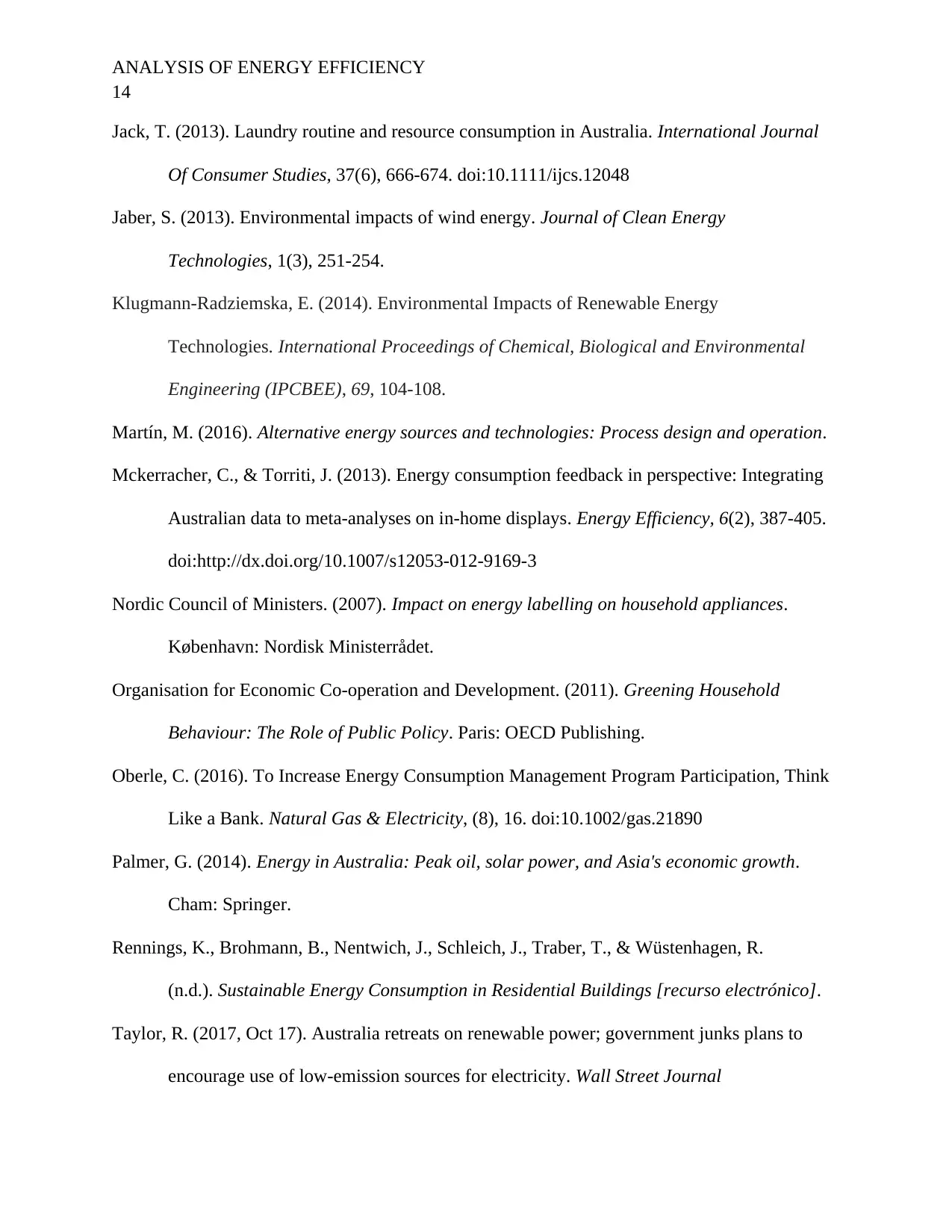
ANALYSIS OF ENERGY EFFICIENCY
14
Jack, T. (2013). Laundry routine and resource consumption in Australia. International Journal
Of Consumer Studies, 37(6), 666-674. doi:10.1111/ijcs.12048
Jaber, S. (2013). Environmental impacts of wind energy. Journal of Clean Energy
Technologies, 1(3), 251-254.
Klugmann-Radziemska, E. (2014). Environmental Impacts of Renewable Energy
Technologies. International Proceedings of Chemical, Biological and Environmental
Engineering (IPCBEE), 69, 104-108.
Martín, M. (2016). Alternative energy sources and technologies: Process design and operation.
Mckerracher, C., & Torriti, J. (2013). Energy consumption feedback in perspective: Integrating
Australian data to meta-analyses on in-home displays. Energy Efficiency, 6(2), 387-405.
doi:http://dx.doi.org/10.1007/s12053-012-9169-3
Nordic Council of Ministers. (2007). Impact on energy labelling on household appliances.
København: Nordisk Ministerrådet.
Organisation for Economic Co-operation and Development. (2011). Greening Household
Behaviour: The Role of Public Policy. Paris: OECD Publishing.
Oberle, C. (2016). To Increase Energy Consumption Management Program Participation, Think
Like a Bank. Natural Gas & Electricity, (8), 16. doi:10.1002/gas.21890
Palmer, G. (2014). Energy in Australia: Peak oil, solar power, and Asia's economic growth.
Cham: Springer.
Rennings, K., Brohmann, B., Nentwich, J., Schleich, J., Traber, T., & Wüstenhagen, R.
(n.d.). Sustainable Energy Consumption in Residential Buildings [recurso electrónico].
Taylor, R. (2017, Oct 17). Australia retreats on renewable power; government junks plans to
encourage use of low-emission sources for electricity. Wall Street Journal
14
Jack, T. (2013). Laundry routine and resource consumption in Australia. International Journal
Of Consumer Studies, 37(6), 666-674. doi:10.1111/ijcs.12048
Jaber, S. (2013). Environmental impacts of wind energy. Journal of Clean Energy
Technologies, 1(3), 251-254.
Klugmann-Radziemska, E. (2014). Environmental Impacts of Renewable Energy
Technologies. International Proceedings of Chemical, Biological and Environmental
Engineering (IPCBEE), 69, 104-108.
Martín, M. (2016). Alternative energy sources and technologies: Process design and operation.
Mckerracher, C., & Torriti, J. (2013). Energy consumption feedback in perspective: Integrating
Australian data to meta-analyses on in-home displays. Energy Efficiency, 6(2), 387-405.
doi:http://dx.doi.org/10.1007/s12053-012-9169-3
Nordic Council of Ministers. (2007). Impact on energy labelling on household appliances.
København: Nordisk Ministerrådet.
Organisation for Economic Co-operation and Development. (2011). Greening Household
Behaviour: The Role of Public Policy. Paris: OECD Publishing.
Oberle, C. (2016). To Increase Energy Consumption Management Program Participation, Think
Like a Bank. Natural Gas & Electricity, (8), 16. doi:10.1002/gas.21890
Palmer, G. (2014). Energy in Australia: Peak oil, solar power, and Asia's economic growth.
Cham: Springer.
Rennings, K., Brohmann, B., Nentwich, J., Schleich, J., Traber, T., & Wüstenhagen, R.
(n.d.). Sustainable Energy Consumption in Residential Buildings [recurso electrónico].
Taylor, R. (2017, Oct 17). Australia retreats on renewable power; government junks plans to
encourage use of low-emission sources for electricity. Wall Street Journal
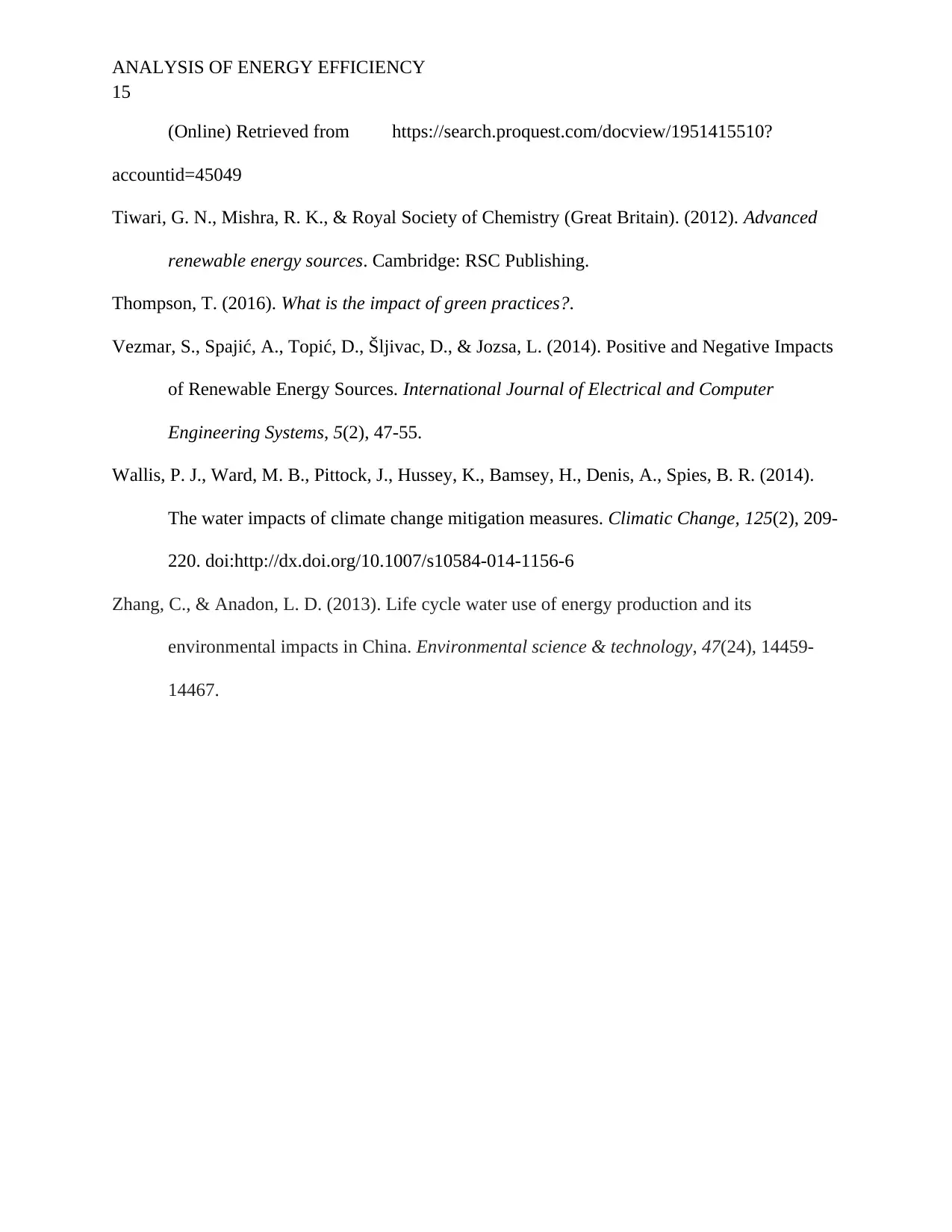
ANALYSIS OF ENERGY EFFICIENCY
15
(Online) Retrieved from https://search.proquest.com/docview/1951415510?
accountid=45049
Tiwari, G. N., Mishra, R. K., & Royal Society of Chemistry (Great Britain). (2012). Advanced
renewable energy sources. Cambridge: RSC Publishing.
Thompson, T. (2016). What is the impact of green practices?.
Vezmar, S., Spajić, A., Topić, D., Šljivac, D., & Jozsa, L. (2014). Positive and Negative Impacts
of Renewable Energy Sources. International Journal of Electrical and Computer
Engineering Systems, 5(2), 47-55.
Wallis, P. J., Ward, M. B., Pittock, J., Hussey, K., Bamsey, H., Denis, A., Spies, B. R. (2014).
The water impacts of climate change mitigation measures. Climatic Change, 125(2), 209-
220. doi:http://dx.doi.org/10.1007/s10584-014-1156-6
Zhang, C., & Anadon, L. D. (2013). Life cycle water use of energy production and its
environmental impacts in China. Environmental science & technology, 47(24), 14459-
14467.
15
(Online) Retrieved from https://search.proquest.com/docview/1951415510?
accountid=45049
Tiwari, G. N., Mishra, R. K., & Royal Society of Chemistry (Great Britain). (2012). Advanced
renewable energy sources. Cambridge: RSC Publishing.
Thompson, T. (2016). What is the impact of green practices?.
Vezmar, S., Spajić, A., Topić, D., Šljivac, D., & Jozsa, L. (2014). Positive and Negative Impacts
of Renewable Energy Sources. International Journal of Electrical and Computer
Engineering Systems, 5(2), 47-55.
Wallis, P. J., Ward, M. B., Pittock, J., Hussey, K., Bamsey, H., Denis, A., Spies, B. R. (2014).
The water impacts of climate change mitigation measures. Climatic Change, 125(2), 209-
220. doi:http://dx.doi.org/10.1007/s10584-014-1156-6
Zhang, C., & Anadon, L. D. (2013). Life cycle water use of energy production and its
environmental impacts in China. Environmental science & technology, 47(24), 14459-
14467.
1 out of 15
Related Documents
Your All-in-One AI-Powered Toolkit for Academic Success.
+13062052269
info@desklib.com
Available 24*7 on WhatsApp / Email
![[object Object]](/_next/static/media/star-bottom.7253800d.svg)
Unlock your academic potential
© 2024 | Zucol Services PVT LTD | All rights reserved.





